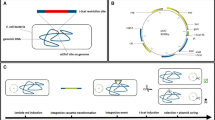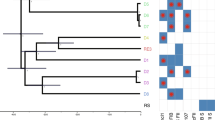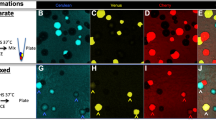Abstract
Concern has been shown in the scientific community with regard to the potential risk that the transmission of foreign genes from Escherichia coli K12-cloning vector systems to other micro-organisms might represent1. Because of this we have attempted to evaluate the frequency in nature of E. coli strains that can serve as recipients and/or hosts for genetic information harboured by various E. coli cloning vectors used in recombinant DNA research. We assumed that genetic transfer from E. coli K12 to other E. coli strains was more likely than to bacteria of other species or genera, and consequently examined natural E. coli isolates for traits that would reflect their ability to propagate and/or maintain cloning vectors. In particular, we were interested in assessing the role that transduction might have in the dissemination of cloned genetic information. We also wanted to determine whether naturally occurring strains could acquire and stably maintain phage λ derived cloning vectors that generally contain amber mutations in essential genes2–4. By examining natural bacterial populations we attempted to evaluate the fitness of auxotrophic mutations that are generally introduced into E. coli K12 hosts used in recombinant DNA experiments. Therefore, we determined among natural isolates of E. coli frequency of strains exhibiting: (1) sensitivity to phages P1 and λ; (2) amber suppressor mutations; and (3) auxotrophic mutations. The results presented here allow an estimation of the feasibility and limitations of the successful spread among E. coli strains in nature of recombinant DNA molecules contained in particular E. coli K12 hosts.
This is a preview of subscription content, access via your institution
Access options
Subscribe to this journal
Receive 51 print issues and online access
$199.00 per year
only $3.90 per issue
Buy this article
- Purchase on Springer Link
- Instant access to full article PDF
Prices may be subject to local taxes which are calculated during checkout
Similar content being viewed by others
References
Curtiss, R. III A. Rev. Microbiol. 30, 507–533 (1976).
Blattner, F. R. et al. Science 196, 161–169 (1977).
Donoghue, D. J. & Sharp, P. A. Gene 1, 209–227 (1977).
Leder, P., Tiemier, D. & Enquist, L. Science 196, 175–177 (1977).
Goldberg, R. B., Bender, R. A. & Streicher, S. L. J. Bact. 118, 810–814 (1974).
Kaiser, D. & Dworkin, M. Science 187, 653–654 (1975).
Rosner, J. L. Virology 48, 679–689 (1972).
Jacob, F. & Wollman, E. L. Annls. Inst. Pasteur, Paris 91, 499–510 (1957).
MacHattie, H. A. & Jackowski, J. B. in ‘DNA Insertion Elements, Plasmids and Episomes’ (eds Bukhari, A. J., Shapiro, J. A., & Adhya, S. L.) 219–228 (Cold Spring Harbor Laboratory, New York, 1977).
Jacob, F. & Wollman, E. L. Annls. Inst. Pasteur, Paris 87, 653–673 (1954).
Mindich, L., Cohen, J. & Weisburd, M. J. Bact. 126, 177–182 (1976).
Cavalli, L. L. & Heslot, H. Nature 164, 1057–1058 (1949).
Lennox, E. S. Virology, 1, 190–206 (1955).
Curtiss, R. III et al. in ‘Recombinant Molecules: Impact on Science and Society, (eds Beers, R. F., Jr & Basset, E. G.) 45–56 (Raven, New York, 1977).
Mojica-a, T. & Middleton, R. J. Bact. 198, 1161–1167 (1971).
Curtiss, R. III J. Bact. 89, 28–40 (1965).
Author information
Authors and Affiliations
Rights and permissions
About this article
Cite this article
Robeson, J., Goldschmidt, R. & Curtiss, R. Potential of Escherichia coli isolated from nature to propagate cloning vectors. Nature 283, 104–106 (1980). https://doi.org/10.1038/283104a0
Received:
Accepted:
Issue Date:
DOI: https://doi.org/10.1038/283104a0
This article is cited by
Comments
By submitting a comment you agree to abide by our Terms and Community Guidelines. If you find something abusive or that does not comply with our terms or guidelines please flag it as inappropriate.



